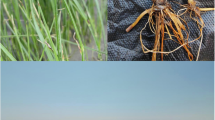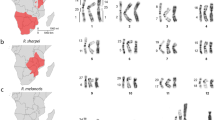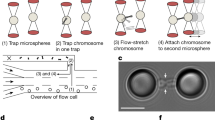Abstract
The meiotic chromosomes of the grasshopper, Chrotogonus incertus Bolivar (collected at Allahabad), assume typical ‘lampbrush’ appearance at pachytene, which condition persists to the end of diakinesis, but disappears completely at the first metaphase. This condition has been reported by Hsu1 in two different species of grasshoppers, and, judging from illustrations, it seems to have been observed in grasshoppers by other investigators also, even though they do not explicitly describe it2,3. Hsu1 has put forward an ingenious theory, based essentially on Goldschmidt's4 interpretation of the ‘lampbrush’ chromosome, which links up spiralization, heteropycnosis and the formation of ‘lampbrush’ processes. According to him, heterochromatinic heteropycnosis is not due, at least not entirely, to differential nucleic acid synthesis5, but to a difference in the capacity to undergo cyclic condensation. Negative heteropycnosis results from the fact that the intracellular conditions permit the growth of ‘lampbrush’ fibres on the X-chromosome, whereas the autosomes become compactly coiled. Positive heteropycnosis results when the conditions are reversed; the X-chromosome undergoes condensation, but not the autosomes, which, in consequence, show the ‘lampbrush’ fibres. Polymerization of the nucleoprotein, he claims, causes the chromosomes either to be coiled or show ‘lampbrush’ fibres. Now in the spermatocytes of Chrotogonus, late diakinetic chromosomes, although considerably condensed and consequently much shorter than the pachytene threads, are provided with ‘lampbrush’ fibres similar in size and shape to those of the earlier stages. So, condensation (spiralization) and ‘lampbrush’ formations can exist simultaneously in a chromosome. Further, the negatively heteropycnotic X-chromosome of early spermatogonial metaphase is not reported to possess ‘lampbrush’ fibres6,7. Also, in certain special cases, the rates of reproduction of euchromatin and heterochromatin have been found to be appreciably different8, so the differences between them may be more fundamental than Hsu's1 hypothesis assumes. In Chrotogonus the ‘lampbrush’ fibres spring from deeply stainable beads on the chromonemata. Such beads Serra9 claims to have resolved, on careful observation, into parts of a helicoidal coil of four chromonemata. He considers the ‘hairs’ of such chromosomes to be rod-like structures of nucleoplasm deposited on the chromonemata, and, in a lesser degree, the coils of chromonemata themselves. In view of the fact that the staining properties of the ‘lampbrush’ fibres are similar to those of the rest of the chromosome, and the almost unstaining nucleoplasm at these stages is markedly poor in nucleic acids, Serra's9 view is scarcely plausible. It is more in consonance with known facts to consider the ‘lampbrush’ bristles as arising from the peripheral nucleoprotein matrix surrounding the chromonemata10.
This is a preview of subscription content, access via your institution
Access options
Subscribe to this journal
Receive 51 print issues and online access
$199.00 per year
only $3.90 per issue
Buy this article
- Purchase on SpringerLink
- Instant access to full article PDF
Prices may be subject to local taxes which are calculated during checkout
Similar content being viewed by others
References
Hsu, T. C., J. Gen., 48, 311 (1948).
Hearne, E. M., and Huskins, C. L., Cytologia, 6, 123 (1935).
Wilson, E. B., “The Cell in Development and Heredity” (New York, 1928).
Calvin, M., Kodani, M., and Goldschmidt, R., Proc. U.S. Nat. Acad. Sci., 26, 340 (1940).
Darlington, D. C., and La Cour, J. Gen., 40, 185 (1940).
White, M. J. D., J. Gen., 40, 67 (1940).
Ray Chaudhuri, S. P., and Manna, G. K., J. Exp. Zoo., 114, 421 (1950).
Schultz, J., Cold Spring Harbor Symp. Quant. Biol., 12, 179 (1947).
Serra, J. A., Cold Spring Harbor Symp. Quant. Biol., 12, 192 (1947).
Painter, Th. S., Cold Spring Harbor Symp. Quant. Biol., 9, 47 (1941).
Slizynski, B. M., J. Gen., 49, 242 (1949).
Pollister, A. W., and Ris, H., Cold Spring Harbor Symp. Quant. Biol., 12, 147 (1947).
Author information
Authors and Affiliations
Rights and permissions
About this article
Cite this article
SRIVASTAVA, M. ‘Lampbrush’ Fibres in the Chromosomes of Chrotogonus incertus Bolivar. Nature 167, 775–776 (1951). https://doi.org/10.1038/167775b0
Issue date:
DOI: https://doi.org/10.1038/167775b0
This article is cited by
-
The giant sex chromosomes in the mammal Microtus agrestis
Heredity (1953)



